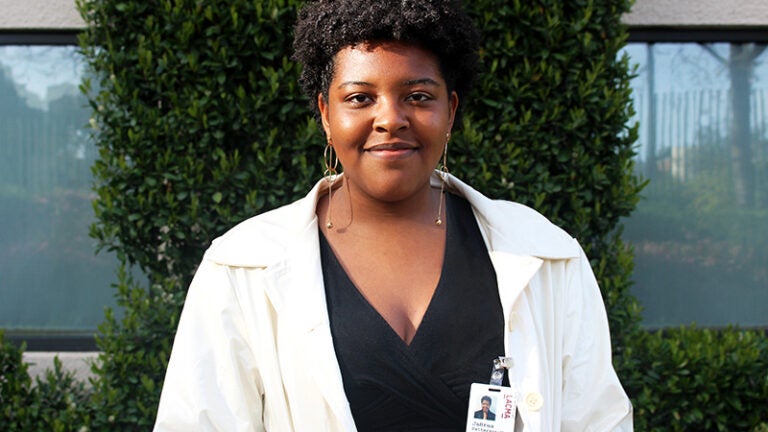
Driven to see black artists celebrated, student moves from pre-med to art history
In the fall of 2020, visitors to the newly refurbished Broad Contemporary Art Museum at the Los Angeles County Museum of Art (LACMA) may pause at Max Pechstein’s painting “Sunlight.” Leaning in for a closer look at this expressionist portrayal of two women standing beneath trees, dappled in summery rays, viewers will learn more about the painting from a nearby placard — written by USC Dornsife student JaBrea Patterson-West.
Patterson-West, an art history and French double major, is already well on her way to a career in the arts, thanks in part to a two-year Mellon Undergraduate Curatorial Fellowship that has supported her mentorship under senior curator Stephanie Barron in LACMA’S modern art department. This summer, she’s writing the extended object label (the informative placard placed next to art works) for the Pechstein painting.
In the fall, she will further expand her horizons when she attends a USC Dornsife study abroad program in Paris, excellent preparation for Patterson-West’s ultimate goals of attending graduate school and then becoming a museum curator in her own right.
The artist’s journey
Patterson-West’s interest in the arts began early. Growing up in New Jersey, she’d tag along on family shopping trips in New York City and gleaned inspiration from the bright clothes for sale on Canal Street and in SoHo. She also visited museums like the Metropolitan Museum of Art, becoming enraptured by historical paintings. She resolved to be the head editor of Vogue.
By the time she arrived at USC, her focus had shifted but her personal aspirations hadn’t. She enrolled as a pre-med student, but then an art history class reignited her interest in the arts. A fruitful discussion with USC Dornsife humanities career adviser Octavio Avila emboldened her to explore creative subjects as a means to a career path. (She now points to advising as an essential step to success.)
This redirection in studies aligned with her burgeoning interest in black artists. The childhood tours through museums had frustrated her; most lacked contemporary black subjects and artists.
“I was going to The Met and the only Black art that you really see is African masks, which, of course, were acquired by means of colonization and invasion,” she says.
It was through social media that she discovered the vibrant community of modern black artists. She cites the blog “Black Contemporary Art,” run by Kimberly Drew, the former social media manager for the Metropolitan Museum of Art, as a key influence. Patterson-West worked with fellow USC Dornsife art history major Julienne Dawidoff to bring Drew to campus for a Visions and Voices event in 2020 that will explore contemporary activism, art and navigating career choices. Now, she aims to bring increased attention to black artists through her future work as a curator and art historian.
Moving beyond identity
Patterson-West’s choice to write about the Pechstein is fitting. The painting’s human subjects may initially dominate the composition, but once the viewer reads the title, they likely go back to scrutinize the way the light falls instead. Art that is not what it immediately seems is right up Patterson-West’s alley.
She’s hoping to tackle a research project on Lynette Yiadom-Boakye, a contemporary British artist who paints portraits of fictitious black subjects. Patterson-West calls them “eidetic,” a psychology term that refers to dream-world imagery. Yiadom-Boakye pieces her subjects together from a hodgepodge of references (books, television, the internet) rather than painting from real-life models. The people look familiar and yet can’t actually be, that uncanny point where a stranger seems briefly like an old friend. She’s so cryptic that she often depicts her subjects without shoes. She considers shoes to be a telling “timestamp.”
To Patterson-West, Yiadom-Boakye’s work harkens back to the post-Black Arts Movement of the 1990s. In response to the Black Power Movement of the 1970s and ’80s, which centered black identity, many artists rejected having their work categorized as simply “black art.”
“They didn’t want to be labeled as black; they simply were black, and so they wanted to have a different kind of discourse,” says Patterson-West.
She believes Yiadom-Boakye’s composite portraits of fictional black characters without personal stories can be seen as a similar rebellion against the way black art and their subject matter is scrutinized only along the lines of identity.
Patterson-West says, “After earlier Feminist and Black Arts movements, we tend to position artists based on their identity politics. But that’s not all there is to the work. These artists are technical; they’re geniuses. And I want to emphasize that.”